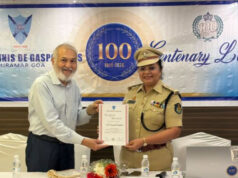After enduring long periods away from home and extreme weather conditions in places like the Arctic and the Antarctic, located on earth’s remote fringe, returning to the mainland is difficult, says science communicator and award-winning filmmaker Rakesh Rao, who shared his experiences in a session titled ‘On Thin Ice: Documenting Science in Earth’s Coldest Corners,’ held at Clube Tennis de Gaspar Dias, Miramar, as a part of the iconic club’s centenary celebration.
“You endure bone-chilling temperatures, rough seas and physical exhaustion. Yet the moment you get back to the mainland after months, you miss it. The silence, the cold…. you just want to go back,” he recalled during his lecture.
Rao’s audio-visual journey carried the audience into the icy worlds of Antarctica, the Arctic and the Himalayas, where he spent over fifteen years documenting the most extreme scientific missions. He has survived blizzards and polar bear habitats, not for the thrill, but to document the untold stories of Earth, science and the people behind it.
“The destination is beautiful and the journey is crazy!” Rao said, laughingly pointing out the irony. From sleeping in tents at 18,000 feet in the Himalayas to flying into Antarctica on Russian IL-76 aircraft with no windows and crossing ice-laden seas aboard cargo ships, Rao’s tales were both adventurous and poignant.
But the most compelling was the strange pull of these cold places. “I have a love-hate relationship with Antarctica,” he said. “The conditions are brutal. But once you’re there, it becomes a part of you. I can’t wait to go back.”
Having the ‘coolest job in the world’, Rao uses visual media to simplify complex research for public understanding. “Scientists publish in technical journals. I document these stories so that the public can relate to it.” His storytelling extends from the lab to the launchpad, Rao also created the official teaser for ISRO’s Chandrayaan-2 mission.
Rao has participated in five expeditions to Antarctica, one to the Arctic and several to the Himalayas. Each journey follows rigorous screening, detailed proposals, multiple ministry-level clearances and a full body health check-up at AIIMS (All India Institute of Medical Science), New Delhi, to ensure that the individual can withstand long durations without accessible healthcare services, after which comes the physical training. “We spend 15 days at the Indo-Tibetan Border Police facility, where we are trained for crevasse rescue, snow trekking and extreme cold survival, all before we even pack for Antarctica,” he explains.
Rao has also documented the construction of Bharati, one of the most technologically advanced Indian bases in the region. He documented the melting glaciers of the Himalayas and the fossilised woods of Antarctica, ancient forests deeply buried.
Beyond science, Rao focussed on the human stories. From a lone woman scientist wintering in Antarctica for a year to helicopter pilots navigating blizzards to extract geological samples, Rao has filmed it all.
Despite the hardships and frostbites, Rao is always planning the next trip. “I often get asked, why go back? I tell them, you’ll understand when you experience it. The cold gets into your soul. And once it’s there, the only cure is going back.”






